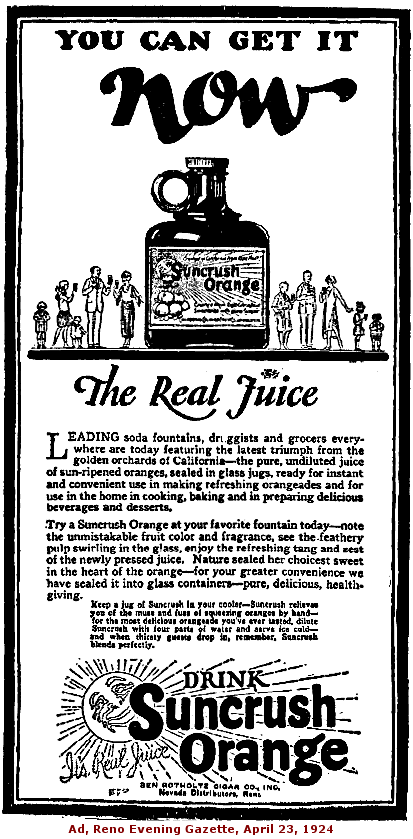
Thursday, June 1, 2006
Page 15
REMINISCING (Column)
Orange Crush Becomes Oft-Cited Example of ‘Suggestive Mark’
By ROGER M. GRACE
Orange Crush, a drink devised by a Los Angeles chemist in 1915 and marketed starting the following year by a company headquartered in Chicago, quickly became a popular soft drink nationwide. Naturally, others created orange-flavored drinks to compete.
One such product, which debuted on Sept. 20, 1920, was “Suncrush Orange,” a concentrate made from orange juice with sugar added. Carbonated water had to be furnished by the consumer or soda jerk to produce a soda pop.
According to an April 23, 1924 ad in the Reno (Nev.) Evening Gazette:
“LEADING soda fountains, druggists and grocers everywhere are today featuring the latest triumph from the golden orchards of California—the pure, undiluted juice of sun-ripened oranges, sealed in glass jugs, ready for instant and convenient use in making refreshing orangeades and for use in the home in cooking, baking and in preparing delicious beverages and desserts.”
|
|
As you might have expected, the Orange-Crush Company was none too pleased by use of the words “***crush” and “orange” in connection with a competing product. When the California Crushed Fruit Co. sought registration of “Suncrush” as a federal trademark, that went too far; the Illinois company filed opposition.
The commissioner of patents rebuffed the opposition, decreeing that “Orange Crush” was unworthy of protection because it was “merely descriptive” of the product. In reversing the decision to permit registration of “Suncrush,” Judge Charles Henry Robb of the U.S. Court of Appeals of the District of Columbia observed in a 1924 opinion:
“[W]hile orange crush, as applied to a beverage, was suggestive, it certainly was not descriptive. A person of average intelligence would not understand, when buying an orange crush drink, that he was getting a crushed orange.”
Robb added:
“The evidence clearly indicates that the concurrent use of ‘Suncrush’ by appellee has resulted in confusion in the mind of the public; but, aside from the evidence, we think it clear that confusion would be the inevitable result of such use.”
That decision has been widely cited through ensuing years as a prime example of a “suggestive” mark. It’s often mentioned in tandem with decisions relating to two other marks of that nature, “Coppertone,” and “Playboy.”
In the earliest days of Suncrush Orange, note could be made—and was—that other products were based on orange flavoring that was synthetic. Indeed, labels on bottles of “Ward’s Orange-Crush,” as it was then known, during much of 1920 bore the prominent advisement: “Contains No Orange Juice.” (The flavoring was from the skin of the oranges, as discussed here last week.)
It might well be suspected that the U.S. government forced the confession that appeared on the labels. The Literary Digest, in its Oct. 30, 1920 issue, reprinted an article from the U.S. Health Reports on phony orange drinks, and said in its own preface:
“‘Orangeade’ and ‘orange crush’ that never came nearer to an orange than the tanks of a synthetic chemical laboratory are no longer to be served under those names with Uncle Sam’s permission.”
So, there was an evident government concern over “orange” drinks containing no orange juice.
The Orange-Crush Company’s interim solution was to include the disclaimer on its labels; its ultimate solution was to incorporate orange juice into its formula, which it did by the end of 1920.
In a Dec. 4 editorial that year, the Literary Digest retracted any implication in its Oct. 30 preface that Orange-Crush was a bogus orange beverage, saying:
“Ward’s Orange Crush, which is the only orange drink marketed under the trade-name ‘crush’, is, as per their label, composed of orange-oil, citric acid, orange juice, pure granulated pane-sugar and water, and colored with United States certified food color.”
The magazine apparently did not realize that at an earlier point that year, orange juice was not an ingredient.
Real orange juice, a perishable, was not incorporated into the drink with complete success at first, as evidenced by the outcome of a lawsuit.
The Orange-Crush Company sold its concentrate to wholesale dealers. One dealer, in Duluth, Minnesota, sent the merchandise back in 1921, asserting that customers had complained as to its quality. In litigation that ensued, the issue was whether there had been a breach of the express warranty which read:
“The concentrates are guaranteed to retain their delicate flavor, and to keep indefinitely in any climate. Orange-Crush Company stands rigidly back of this guarantee, and each order is delivered subject to it.”
That language, a 1923 opinion by the Supreme Court of Minnesota found, was something more than mere “trade talk.” The evidence showed that the warranty was breached, the court held.
Copyright 2006, Metropolitan News Company